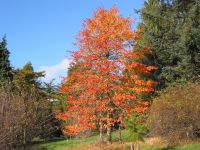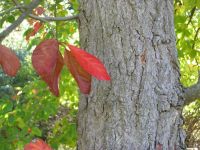Tupelo, Black gum, sour gum - Nyssa sylvatica
English name:
Tupelo, Black gum, sour gum
Scientific name:
Nyssa sylvatica
Family:
Cornaceae (Dogwood family)
Height:
30 M
Flowering:
Late June, early July
Range:
eastern North America from Main to Mexico
 |
|
 |
 |
The 59 year-old Nyssa sylvatica trees in the pictures are from seed sent from Arnold Arboretum, Harvard University, Massachusetts, USA. Two plants can be found to the left of the Main road just before it reaches the turnaround in front of Spejder sø: square 1906, position 4040. A map with squares and positions can be found on our homepage under: Digital plant search of the Arboretum.
Plant description:
October is really the month of autumn colours in the Arboretum. One of the most striking producers of autumn colours is this months plant, Nyssa sylvatica, with its spectacular shinny red and yellow foliage.
The genus Nyssa contains 11 species; 3 from eastern North America, 1 from West Indies and Central America and 7 from East and Southeast Asia. Different sources give quite different numbers of species for this genus, depending on whether some taxa are considered subspecies or species in their own right. This genus has been found as a fossil in Tertiary brown-coal deposits in Europe, including western Denmark. It was once widespread in temperate forests around the northern hemisphere. We have only one species of Nyssa in our collection, although we have tried three other species over the years.
In Nyssa sylvatica, the name Nyssa is derived from for a water nymph in Greek mythology referring to the common occurrence of these plants on moist sites. The name, sylvatica means from the forest. One of the common names tupelo is derived from the North American Creek language referring to a tree from the swamp. Nyssa sylvatica has a long history of introduction into Europe beginning in the 1700s.
Herbarium specimens demonstrate that Nyssa sylvatica was grown in Ålholm park in 1864 and Forest Botanic Garden in Charlottenlund in 1888. Neither of these species has survived for unknown reasons. The largest trees in Denmark appear to be from 1946. Of 5 reported in 1974 only three are left now. All three remaining trees are in the Arboretum in Hørsholm. But a second generation of seed plants has resulted from these trees, including a plant in the Botanic Garden in Copenhagen. One of our three specimens from 1946 regularly produces viable seed. Flowering was first observed on these trees when they were 27 years old. Nyssa sylvatica is not a common tree in Denmark, because of difficulties in transplanting them. Currently the Arboretum has 5 specimens of this species and one also remains in our satellite garden Forest Botanic Garden in Charlottenlund.
Nyssa sylvatica is a deciduous tree with monopodial shoots and simple leaves arising alternatively along the twigs. The bark is grey-brown and develops fissures at an early age. The 5-12 cm long leaves are variable in form with entire margins. They are leathery when grown in full sunlight and have a shinny dark green upper surface. The lower surface is a lighter blue-green with a matt surface. The leaf petiole is red or pink. Leafing out occurs at the end of May in Denmark. Flowers are greenish and not showy and are produced at the ends of long stalks. Trees are normally either male or female but sometimes produce as well a few bisexual flowers. The fruit sits on the end of a long stalk in groups of one to three. They are about 1 cm, oblong, single-seeded, and purple-black with fully ripe. In the Arboretum ripening occurs in about the middle of October.
This strikingly beautiful tree has been listed several times as a potential garden, park or street tree in residential areas where pollution is not heavy. A number of named cultivars occur which are usually selected for their outstanding autumn colour. Although difficult to buy in Denmark there are over 30 sources to choose from in Great Britain. Problems with transplanting can be overcome by growing in containers, provided they are root pruned annually to prevent the taproots from ringing the containers. Nyssa sylvatica is a completely hardy tree in Denmark if the right provenance is found. Translating from Søren Ødum 1974: With its special branching pattern, robust growth and extraordinary beautiful leaves in the summer and autumn, Nyssa sylvatica will be a useful newcomer in gardens and parks her in Denmark and undoubtedly also in the southern parts of Norway, Sweden and Finland. This is also a good tree for attracting wildlife: bees love the flowers, and birds, bears and foxes are reported to like the fruits.
References:
Andrews, Susyn. Tree of the Year: Nyssa. International Dendrological Society Yearbook 2000: 120-158.
Mitchell, A. & Ødum S. 1983. Træer i Nordeuropa (Trees in Northern Europe). Gads Forlag, Copenhagen, pp. 413pp.
Ødum, Søren. 1974 Nyssa sylvatica. Dansk Dendrologisk Årsskrift. 4(1): 45-52.
Olsen, O. et al. 1997 Havens Planteleksikon. Træer og Buske. (Danish Plant Encyclopaedia, Trees & Bushes). Det Danske Haveselskab Publisher, 674 pp.
Philip ,C. & Lord, T. RHS Plant Finder 2004-2005. Royal Horticultural Society & Dorling Kindersley Ltd. Publishers. 952 pp.
Poor, J.M. & Brewster, N.P. 1994. Plants that Merit Attention. Vol II. Trees. Timber Press Publisher.
Rushforth, K. 1999. Trees of Britain and Europe. Harper Collins Publisher. 1336 pp.
